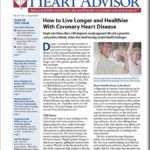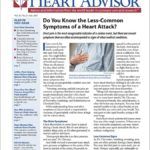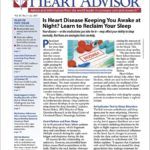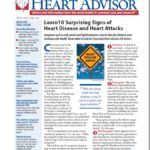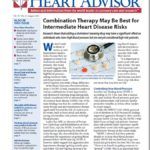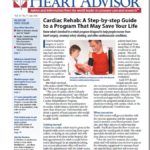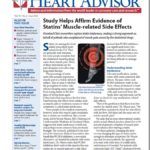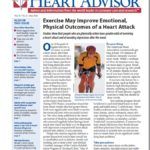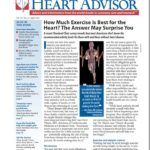Download the Full March 2017 Issue PDF
A diagnosis of coronary heart disease can be emotionally devastating, especially if CHD is discovered after a heart attack. Its quite common for someone to become anxious or depressed after a heart attack or after a procedure, such as coronary artery bypass grafting (CABG) or stenting to open a blocked artery. If you start having feelings of hopelessness or excessive worry, or you find yourself withdrawing from friends, families and activities you once enjoyed, share your feelings with your doctor.
Download the Full February 2017 Issue PDF
There are other very typical symptoms of a heart attack that have nothing to do with chest pain or pressure. These are signs that may or may not appear with chest discomfort. Along with chest pressure, significant shortness of breath and nausea are also common in many heart attacks, Dr. Cho says. Shortness of breath, also called dyspnea, is often felt before any chest pain. You may find yourself unable to take a deep breath, or you may feel like you cant catch your breath. You may pant or take rapid breaths, trying to fill your lungs.
Download the Full January 2017 Issue PDF
That advice goes for cooking oils and everything in your diet. Portion control and moderation are key.When establishing a heart-healthy eating plan, pay close attention to saturated fat and trans fat content, calories, added sugars, sodium and additives such as nitrates and phosphates. Reducing your intake of these potentially harmful items can help boost your odds of preserving the health of your heart and your overall physical well-being.
Download the Full December 2016 Issue PDF
He adds that since the test subjects were younger and healthier than most heart patients, and that the exercise was done on a treadmill, its not certain that similar accuracy issues would be the case for older adults and for other activities. However, the researchers did stress that if you are advised to wear a heart rate monitor because of concerns about your heart health, you should strongly consider a chest monitor. You should also take the monitor to your doctors office or, perhaps to a cardiac rehab specialist, to make sure its working properly and that you know how to use it and read theresults.
Download the Full November 2016 Issue PDF
A patient deemed inoperable still may not be a good TAVR candidate, unfortunately. Arteries that are too small to accommodate a catheter safely, for example, may eliminate TAVR as an option. Dr. Mick notes, however, that recently approved TAVR valves are smaller than earlier generations of the device, meaning more patients may be good candidates. And even if TAVR appears to be a safe choice, open surgery may still be necessary.
Download the Full September 2016 Issue PDF
Research suggests that, on average, Americans consume about 3,400 mg of sodium daily, which is almost 50 percent more than the recommended limit of 2,300 mg. Because most of that sodium is found in processed and restaurant foods, as opposed to the salt shaker, the FDA is focusing its efforts on the food industry. The agency is accepting public comment on its goals. You can share your thoughts with the FDA on its website. Short-term goals call for daily average consumption to reach 3,000 mg in two years and 2,300 mg in 10 years.
Download the Full August Issue PDF
One of the other differences youll notice is in the listing of vitamins, minerals and other nutrients. Calcium and iron will still be listed, but they will be joined by potassium and vitamin D. Vitamins A and C will no longer be required, but may be added voluntarily by the manufacturer. Deficiencies in vitamins A and C are rare, but research suggests that vitamin D and potassium are very important to general nutrition, but that many people dont get enough of them.
Download the Full July 2016 Issue PDF
Confusion also swirls around vitamin K and warfarin. Vitamin K is found in many foods, including leafy green vegetables, such as kale and spinach. Dr. Cho notes that too much vitamin K may reduce the effectiveness of warfarin. However, the foods rich in vitamin K are also part of a heart-healthy diet. She suggests that if you have questions about how much vitamin K is safe, or about any aspect of warfarin therapy, you should talk with your doctor.
Download the Full June 2016 Issue PDF
Restoring normal rhythm led to improved exercise capacity, Dr. Elshazly says. This (study) provides mechanistic evidence that a rhythmcontrol strategy may potentially improve peak exercise capacity and survival, a finding that requires future prospective appraisal in this patient population.
Download the Full May 2016 Issue PDF
Two recent studies have underscored the importance of fitness in lowering your odds of dying of a heart attack and of developing depression following an MI. In one study, based on the Henry Ford Exercise Testing (FIT) Project, researchers found that heart attack victims who had greater fitness levels were significantly more likely to survive the events and have more successful recoveries. The other study, published in the American Journal of Medicine, found that individuals who exercised regularly before having a heart attack were much less likely to to be diagnosed with depression compared with heart attack patients who seldom, if ever, exercised.
Download the Full Issue April 2016 PDF
You know a heart-healthy diet includes plenty of fruits and vegetables, but that leaves a lot of options to choose from in your stores produce section. A recent study in BMJ actually identifies the types of flavonoids and their dietary sources that are best for preventing weight gain over time.


